Archive for June 30, 2017
Thought Leader
June 30, 2017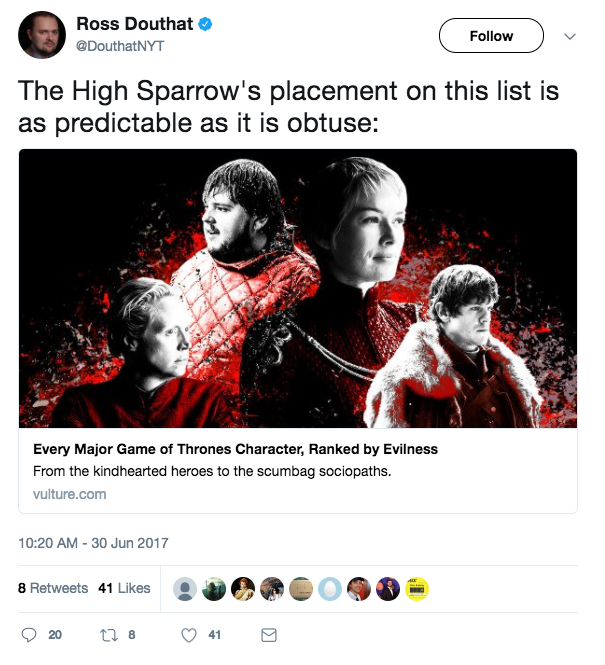
I really couldn’t ask for a more delightful criticism of my Game of Thrones Evil Rankings than Ross Douthat defending the High Sparrow
The A.V. Club’s favorite comics of 2017 so far
June 30, 2017Mirror Mirror II (2dcloud), anthology
As with any anthology, Mirror Mirror II features some entries that will leave more of an impression than others, but the totality of the work presented is both haunting and astounding. Collecting comics, prose, and illustrative work from such luminaries as Clive Barker and Al Columbia, as well as work by younger authors like Céline Loup and Trungles, editors Sean T. Collins and Julia Gfrörer have curated quite the book. The theme unifying all of these pieces is the convergence of the erotic and the macabre—some works being more explicit than others—but that may be the only commonality between them. Each one offers a striking aesthetic vision. And though some will resonate more deeply than others—which works stand out will most certainly depend on the reader—they accumulate to form an impressive volume. An enormity of spectacle is brought to bear on exploring the commingling of the pleasurable with the painful, the fantastic with the nightmarish, and the result is a series of truly shocking and often deeply moving images. Mirror Mirror II is troubling and challenging, but it is also rewarding and stunning—a thrilling experience that readers won’t soon forget. [Shea Hennum]
I’m proud to say that the AV Club selected Mirror Mirror II as one of its favorite comics of the year so far. The reviews for this book have been just wonderful.
The Boiled Leather Audio Hour Episode 64!
June 30, 2017Children of Men (A Patreon Production)
The Boiled Leather Audio Hour goes dystopian this month! By the special request of our Patreon supporter Jason, who earned the right to choose a topic for the podcast by subscribing at the $50 level, Sean & Stefan are taking a deep dive into the world of Children of Men, director Alfonso Cuarón’s gripping 2006 political science-fiction film. Starring Clive Owen and Julianne Moore and set in a near future where the world has been rocked by an infertility epidemic that has completely ended all childbirths for 18 years and counting, the movie is striking both for its technical virtuosity, particularly during its white-knuckle action sequences, and its emphasis on very human cruelty and empathy. How does its technical prowess affect its message? Where does the storytelling and imagery succeed, and where does it falter? What does its bleak yet ultimately optimistic vision of the future portend for our own grim present? We’ll do our best to answer those questions. Needless to say, spoilers abound!
Additional links:
Abraham Riesman’s article on the making of the film for Vulture.
Our Patreon page at patreon.com/boiledleatheraudiohour.
Our PayPal donation page (also accessible via boiledleather.com).
Every Major Game of Thrones Character, Ranked From Good to Evil
June 29, 2017Jon Snow
A reformer with results. Ned Stark’s (alleged) bastard rose from the ranks to become Lord Commander of the Night’s Watch, then rose from the dead after his underlings murdered him for being too humane to their lifelong enemies, the wildlings. He then helped liberate the North from the bloody grasp of House Bolton. He’s also a generous lover (“You know nothing, Jon Sn — oh!”), a secret Targaryen prince, and most likely the messiah.Sansa Stark
There’s a line in George R.R. Martin’s books about how alone among the Baratheon brothers, Robert was “the true steel,” strong and sharp and flexible and durable. Out of the Stark siblings, Sansa is the true steel. She’s shaken off a short lifetime of sexist princess stories, survived the lethal court intrigues of King’s Landing, weathered the untoward attentions of Littlefinger and the Hound, outlived her rapist Ramsay Bolton, and saved her brother Jon’s life. It’s possible that Petyr Baelish may win her over to the dark side, but until that happens, she’s on the side of the angels.Eddard Stark
Ned is dead, but he didn’t deserve to be. He made moral compromises over the course of his life, from lying to his wife Catelyn and everyone else about Jon’s parentage (including Jon himself) to playing the game of thrones alongside his dissolute old friend King Robert. But in the end, he sacrificed his honor to save his daughters’ lives. It’s not his fault that Cersei, Joffrey, and Littlefinger repaid his kindness with a knife in the back and a sword through the neck.
93 Shades of Gray: Because I am insane, I ranked every major Game of Thrones character in ascending order of evilness for Vulture. This trio of faves is on the good end of the spectrum.
“Twin Peaks” thoughts, Season Three, Episode Eight
June 26, 2017What is clear is the birth of Bob’s bracing message. This disturbing, disorienting episode explicitly ties the demon’s creation to the atom bomb’s detonation, an act of man that rivals, or betters, the dark deeds of any religion’s devil. The connection is no accident. Nor is it without precedent: Ever since the original Twin Peaks introduced supernatural horror into its director’s body of work, the link between otherworldly evil and real-world brutality has been a constant. Lynch treats human cruelty like a rupture in the fabric of reality through which demons of every shape and size can enter — think Lost Highway‘s white-faced Mystery Man, Mulholland Drive‘s monstrous dumpster-dweller and gibbering old folks, Inland Empire‘s balloon-faced Phantom and, of course, the dwellers of the Black Lodge. They all feed on and perpetuate the cycle of violence that enabled their emergence.
Some experiences and emotions are so cataclysmic that our everyday imagery and vocabulary cannot possibly do them justice; monsters give shape to those feelings, the same way an aria in an opera or a song in a musical gives human passion a voice. In crafting creatures like that denim-clad monster and his dark brethren, Lynch is doing what all great horror does. He’s taking the agony and fear we already feel and, like Dr. Frankenstein in his lightning-streaked laboratory, bringing it to unholy life. The real question this episode asks, then, is no more or less than the one pilot Robert A. Lewis asked when he dropped the atomic bomb on Hiroshima: “My God, what have we done?”
MIRROR MIRROR II @ Amazon
June 24, 2017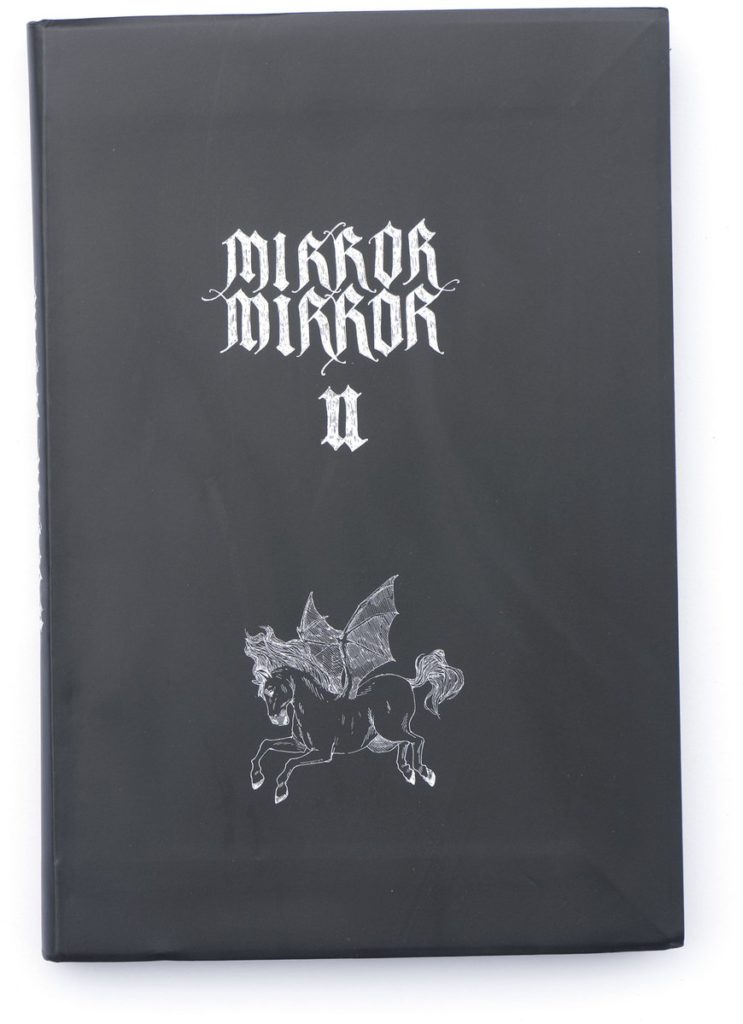

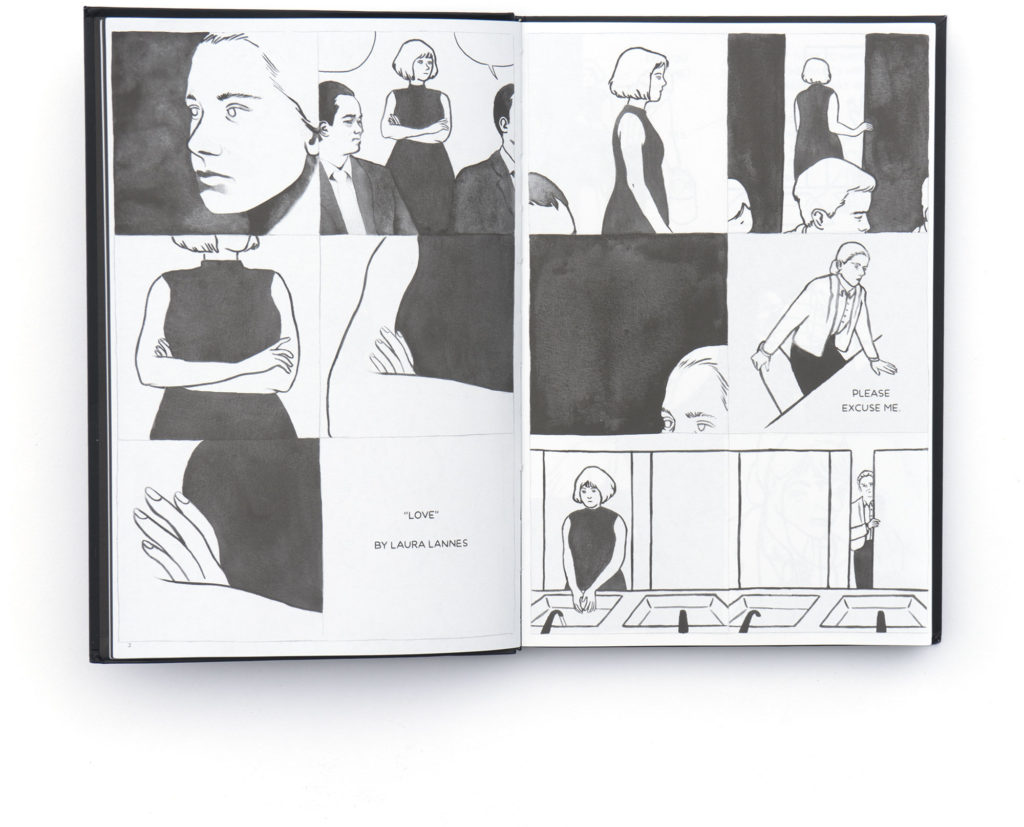
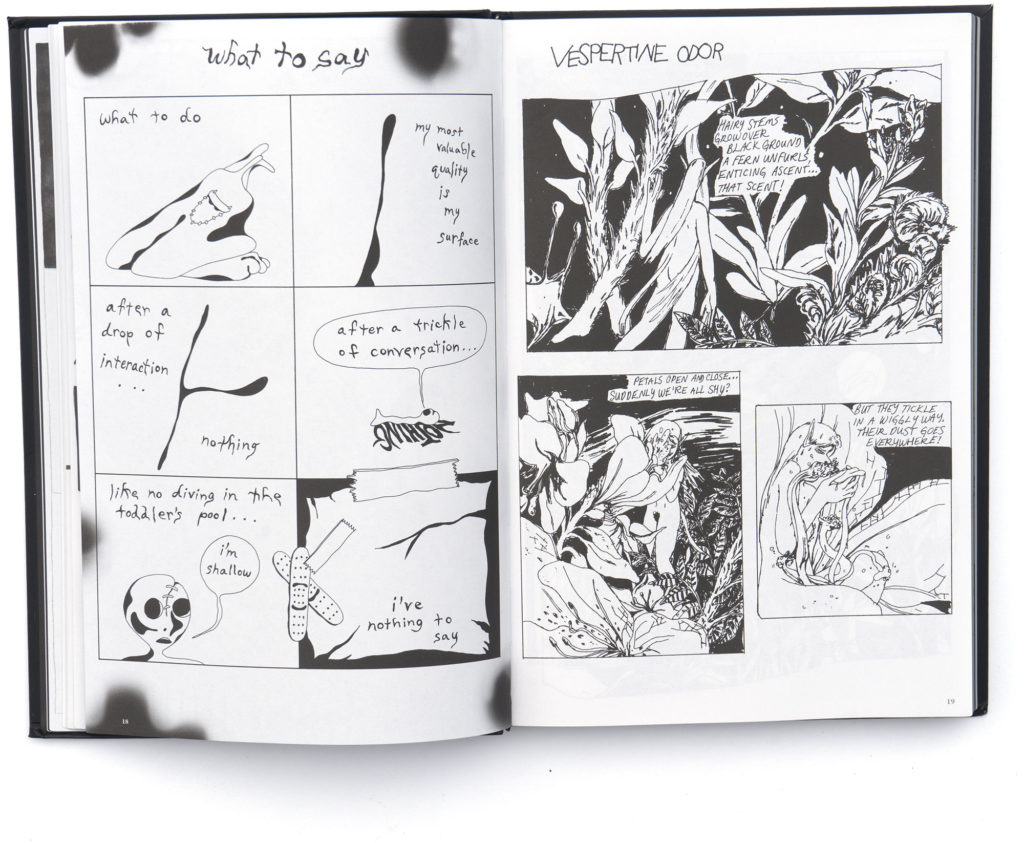
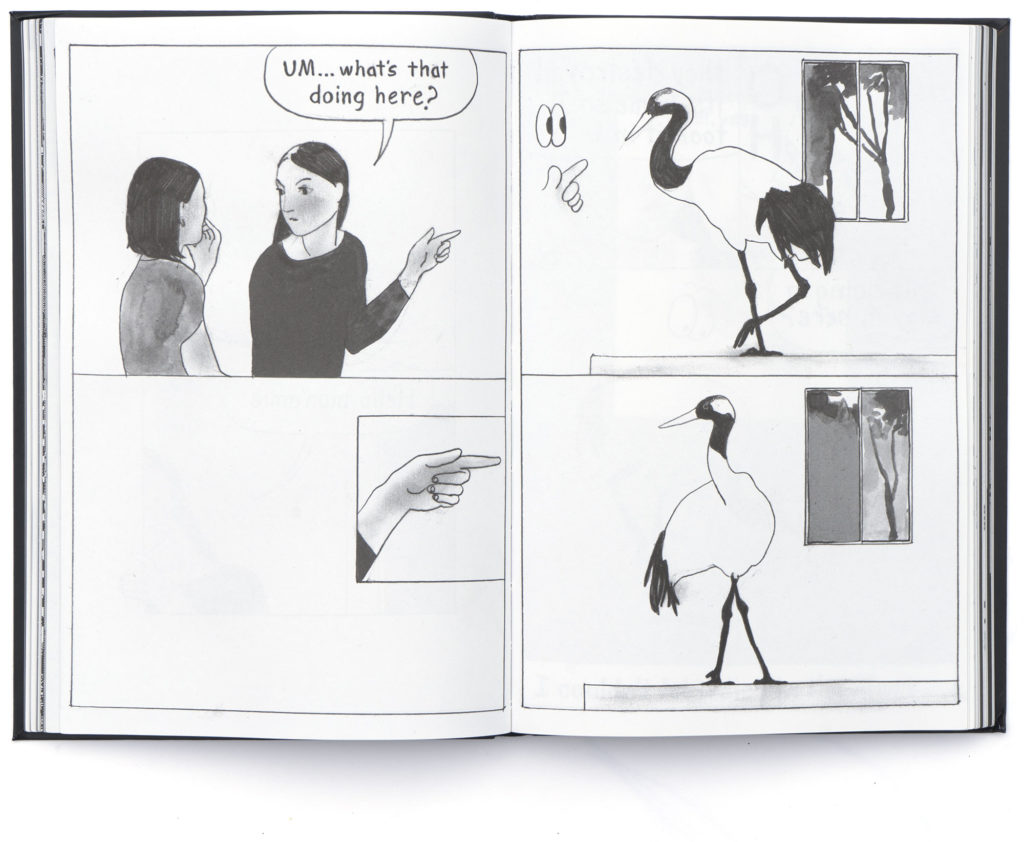
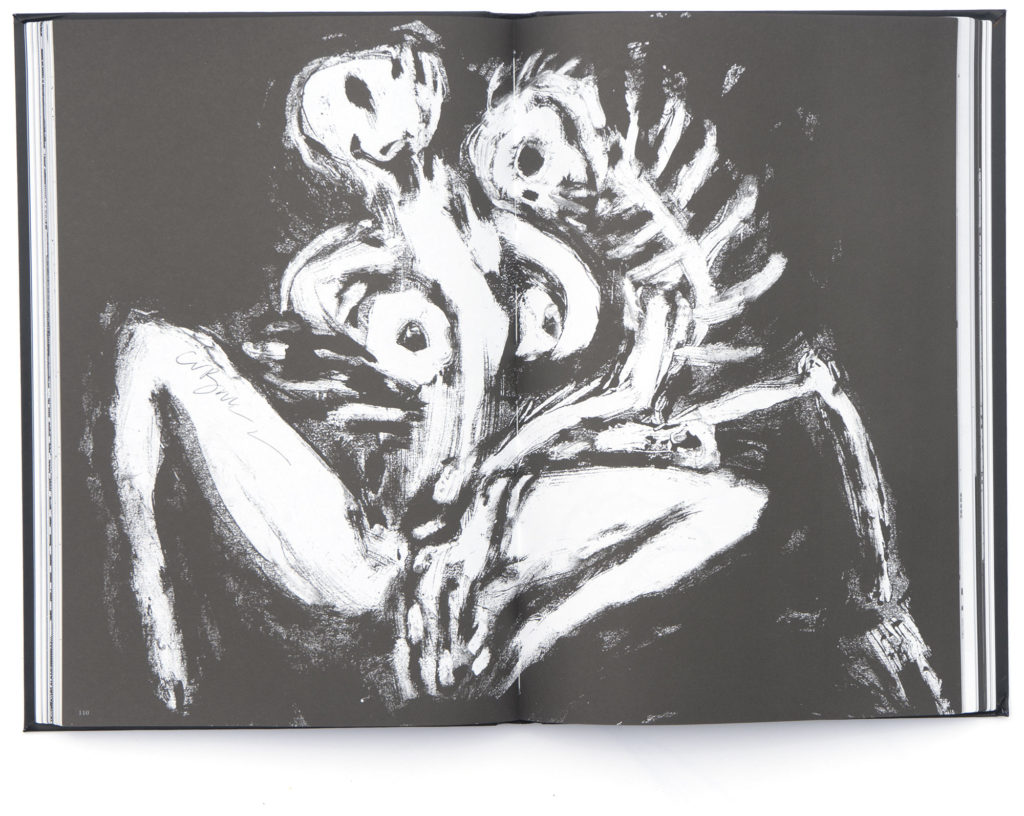
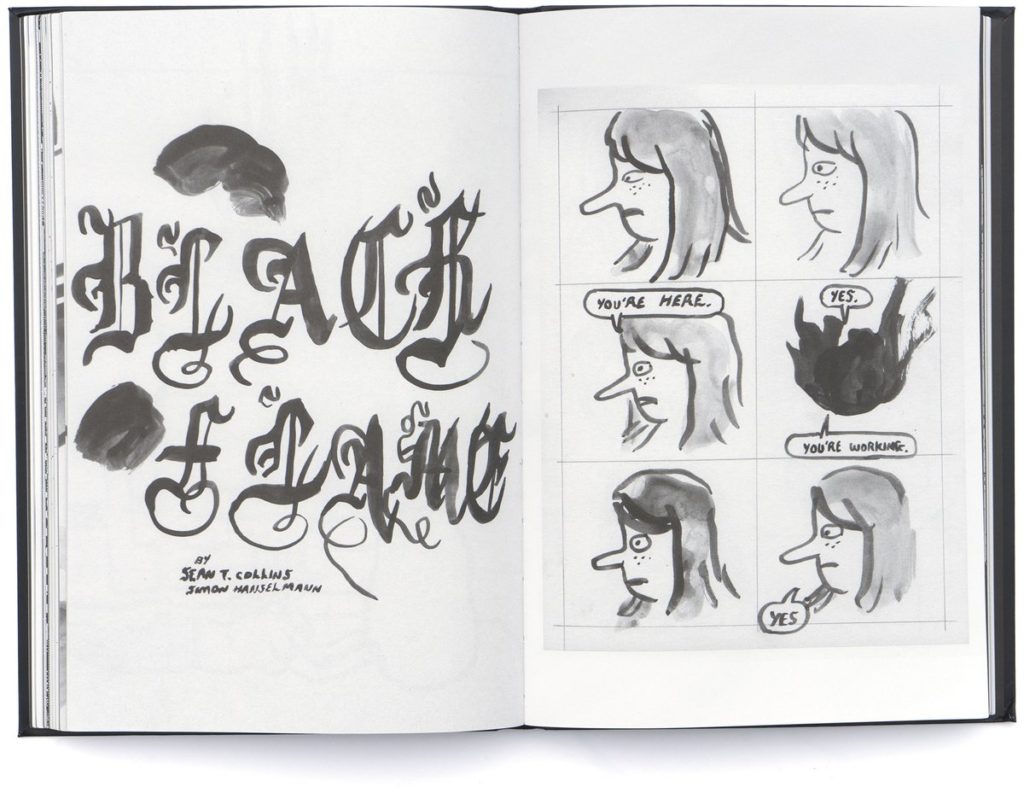
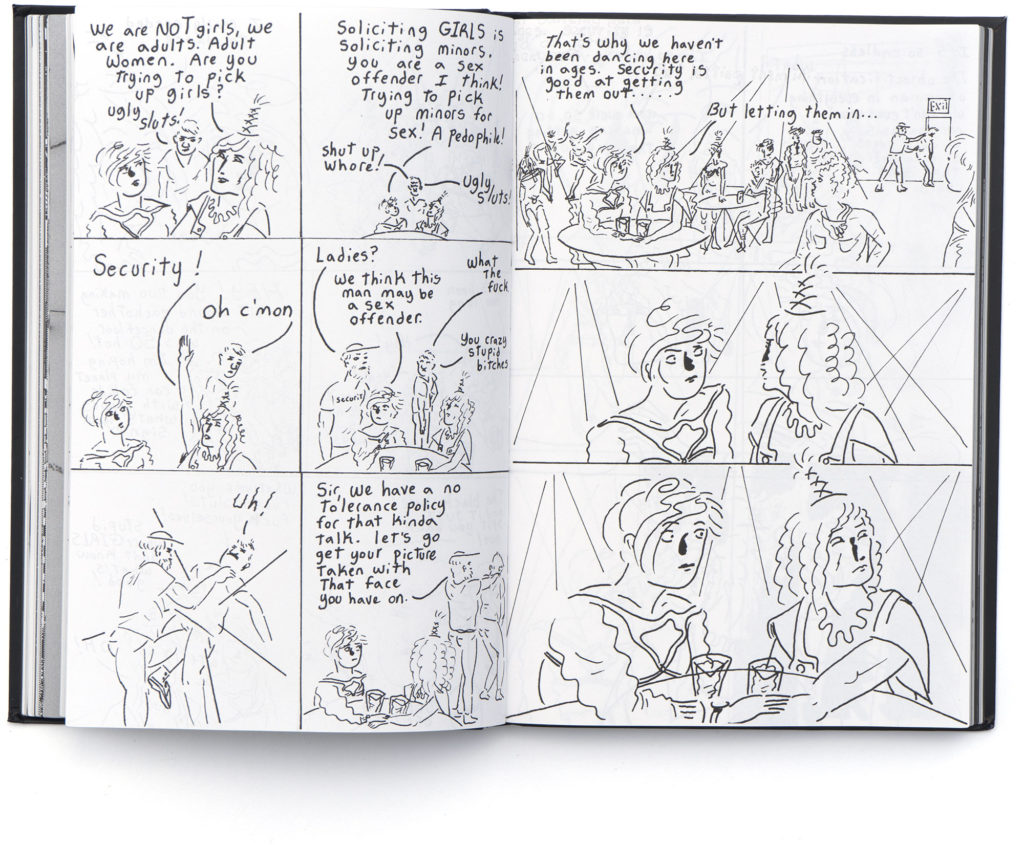
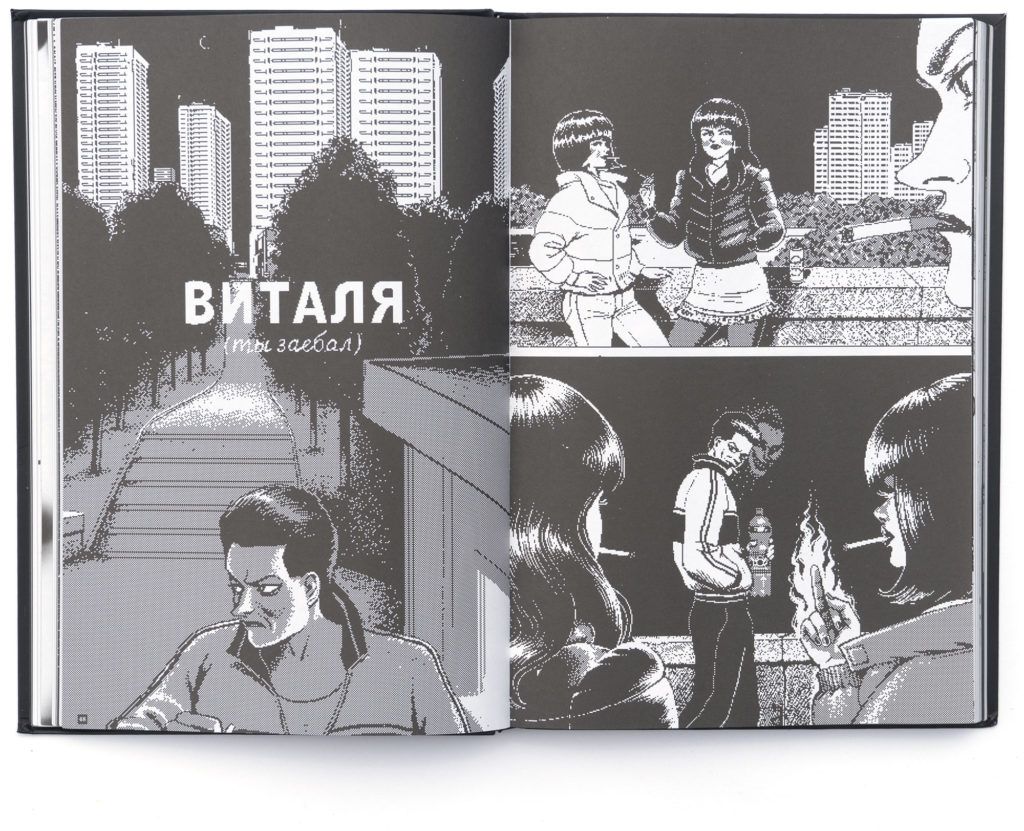
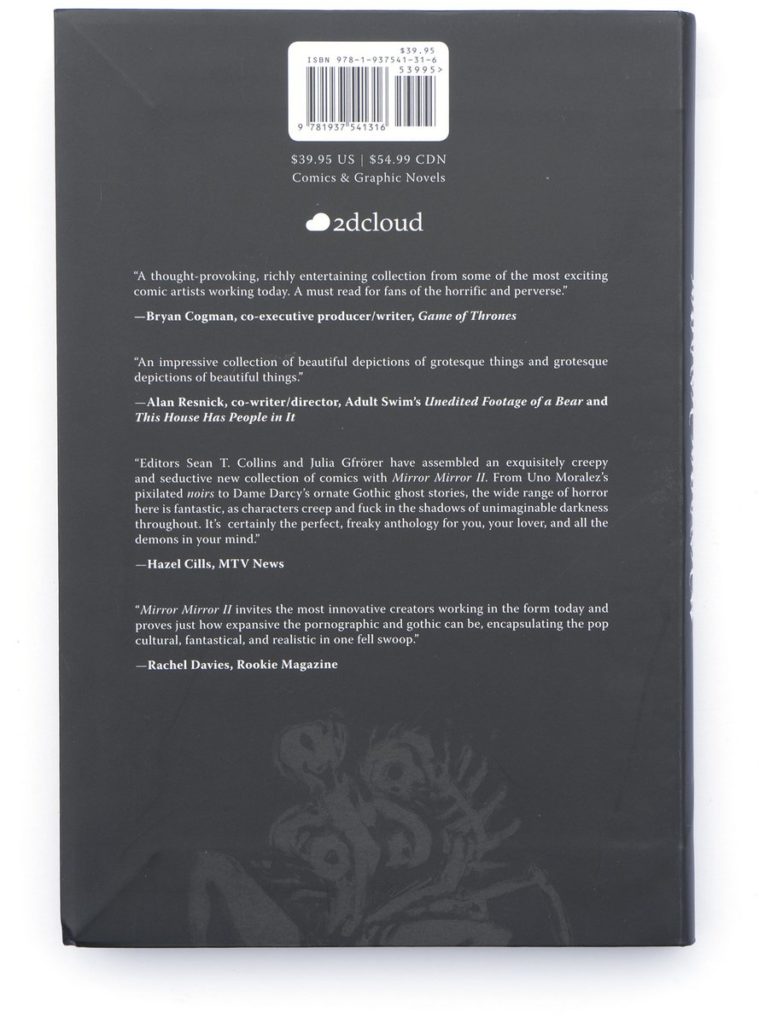
Mirror Mirror II is now available for purchase at Amazon. It’s already shipped, and people have already received their copies. You can order it from Amazon, or pre-order it from our publisher 2dcloud — copies will ship soon.
I’m so glad this book is in the world for you.
“Fargo” thoughts, Season Three, Episode Ten: “Somebody to Love”
June 24, 2017The question facing us is simple. Does Varga walk away, or is he locked up? Will he exalt himself like the eagle and make his next among the stars, or will the Lord bring him down? Is Schrödinger’s metaphorical cat dead or alive? Is the ethical universe half-full or half-empty? The lady, or the tiger?
I want to focus on writer Frank R. Stockton’s extremely famous short story of that name here, because I think the ending of this episode will be similarly misconstrued. The gist of “The Lady, or the Tiger?” is simple enough: In ancient times, a barbaric king offers a condemned man a choice inside a gladiator-style arena where two doors stand before him. Behind one is a ravenous tiger that will devour him on the spot; behind the other is a beautiful woman who will marry him on the spot. The process is completely random, and the prisoner has a fifty-fifty chance of life or death. (“Call it.”)
At least that’s the version of the story you may recall from the dim recesses of memory of English classes gone by. In reality the situation’s a lot more complicated. For one thing, if you get lucky and wind up with the lady, the capricious king will insist you marry her no matter your previous familial commitments or romantic entanglements. Happily married already? Tough luck.
For another, the specific case at the center of the story is a unique one. The condemned man in question, described by the story’s narrator in a sardonic and self-aware voice not far removed from that of Fargo’s occasional voice-over commentators as “a young man of that fineness of blood and lowness of station common to the conventional heroes of romance who love royal maidens,” has been sentenced to this ordeal for the crime of falling in love with the king’s daughter. Like her father, the princess is herself a barbarian by nature, and through sheer force of will has discovered the secret of what lies behind each door. But that same barbarian blood makes her intensely jealous of the other lady in the equation, to whom her suitor will be betrothed should he dodge that tiger-shaped bullet. It’s up to her to signal to the dude which door he should take, and up to us to guess whether she’s sent him to his death or to a life without her, a fate less bloody but possibly no less cruel, in the princess’ eyes anyway.
Apply these lessons to our current story, and the simple choice between good and evil we’re asked to make when we speculate about the outcome of Varga and Gloria’s meeting becomes way less simple.
I reviewed the finale of Fargo Season Three, and quite possibly Fargo itself, for Decider. I think it’s a far more complex episode than surface readings of its ending give it credit for, and I think overall it may be the season that haunts me most.
“Better Call Saul” thoughts, Season Three, Episode Ten: “Lantern”
June 20, 2017In the gorgeously shot sequence that helps open the episode (following the portentous cold-open flashback in which young Chuck assures young Jimmy that everything will be alright in the story they’re reading by lantern-light together), Howard faces the older man down across the lighted arches of HHM’s conference table, before dismissing the other partners so they can speak alone. Actor Patrick Fabian is…well, after seeing him in this role, where he has to take his natural USA Network blue-sky legal-eagle-drama good looks and imbue them with complexity and depth, you wanna see him sink his teeth into something even juicier. For now, though, he’s completely convincing as a straight-and-narrow, buttoned-up guy who worked for years to protect a man he considered a friend, only for that friend to attack him when he dared suggest a different course of action. “Your first instinct is to sue me?” he asks, the incredulity written all over his face. He winds up buying Chuck out of the firm using funds drawn from his own pocket. The ensuing faux-farewell scene, in which the entire office floods the foyer to wish Chuck goodbye, is like something out of The Young Pope—figures lining balconies, overhead shots of curvilenear staircases, a system working in concert to expel a person who does not belong.
This leaves us with Chuck himself. Between his humiliation at HHM and his severing of ties with Jimmy, he suffers a psychological blow that not even his hard-fought recovery from psychosomatic illness can surmount. At first I was kind of bummed out by what ensued: prestige TV’s umpteenth homage to The Conversation, as Chuck’s mental dissolution is metaphorically depicted by his dismantling and destruction of his house in search of a stray electrical current he can’t seem to shut off at the source. But between Michael McKean’s go-for-broke performance and Dave Porter’s evocative, trumpet-based score, something happens that transcends the sequence’s origin. Before too long it’s clear that something deeper than metaphor is at work. Chuck is losing his mind, permanently. As in, it’s lost. He’ll never find it again.
The episode ends with an image that’s all but nauseating in its unfiltered depiction of this loss. With his house a debris-strewn ruin, Chuck sits at his desk, eyes vacant, his legs repeatedly—almost automatically—kicking. The only satisfaction remaining to him is that of destruction, a feeling his brother Jimmy knows only too well. He just kicks and kicks and kicks at his desk until, finally, his lantern falls off, and explodes, and starts a fire we witness silently from across the street. Chuck has no friends, no family, no sanity. But death is always there for you, waiting. Like the brother you wish you had.
I reviewed the beautiful season finale of Better Call Saul for the New York Observer.
How ‘Better Call Saul’ Secretly Became One of TV’s Best Dramas
June 20, 2017Better Call Saul has also secretly morphed into one of the most visually accomplished shows on the air. Bad‘s riotous visuals echoed its chaotic plot, but this prequel has taken a more austere, slow-and-steady approach to its storytelling – and its cinematography follows suit. Directors of photography Arthur Albert (for Seasons One and Two) and Marshall Adams (his successor for Season Three) favor shot compositions that emphasize the geometry of the spaces that Jimmy & co. find themselves in: rectangular windows, square glass bricks, the diagonal slash of a staircase, the glowing arches of a conference table’s lights. The result is an elegant claustrophobia, in which the characters look pinned to a grid or a game board, unable to control their own movements.
And during the show’s third season, Adams adapted Albert’s already impressive use of different lighting styles into a cleverly coded system, to the point where you could almost tell which character’s story we’d be following before they appeared on screen. Jimmy’s segments are brightly lit by the New Mexico sun or by the glare office-light fluorescents, casting a spotlight on his sins. Chuck exists in a shadowy world of his own making, silhouetted in the darkness of his house against a clean white haze of daylight from his windows or the glow of his indoor lantern. Mike’s nocturnal prowlings are given an amber yellow cast – the color of caution, warning and ear, all subliminally signaling us to slow down and watch out.
Saul Mighty: With some help from editor David Fear, I wrote about how Better Call Saul transcended its prequel roots to become one of the best shows on television for Rolling Stone.
“Twin Peaks” thoughts, Season Three, Episode Seven
June 19, 2017The third pseudo-ominous scene, and we’re gonna guess it’s the one that gets people talking, takes place in the Bang Bang Bar, a.k.a. the Road House, a.k.a. the place where we just sit around and watch a guy sweep up debris from the floor for nearly the entire duration of “Green Onions” by Booker T. and the MGs. Why? The answer that springs to mind is “why the hell not,” and hey, that’s perfectly valid. But the phone conversation that ends the scene, in which Jean-Michel Renault (no, not the long-dead sleazebag Jacques, but one of his equally gross relatives) rants and raves about the 15-year-old girls he pimped out to an unhappy client, provides a different answer. What you’ve got here is the banality of evil: A dude who can sit around twiddling his thumbs to an old R&B classic, then pick up the phone and crack jokes about statutory rape. As Jacques would say in a thick French-Canadian accent, “Bite ze bullet, baby.”
I reviewed last night’s tense and clever Twin Peaks for Rolling Stone.
“American Gods” thoughts, Season One, Episode Eight: “Come to Jesus”
June 19, 2017Mr. Wednesday’s war has come, but we’ve gotten his target wrong all along. Sure, he wants to unite the surviving old gods of the world’s various fallen faiths and pantheons against the New Gods of American hegemony—technology, the media, guns, commercialization, and the military-industrial-corporate-intelligence-government complex represented by the mysterious Mr. World. But attacking we the people is his way to win. In “Come to Jesus,” the eight and final episode of American Gods’ spectacular misfire of a first season, the war begins — a biological war in which Wednesday recruits Ostara, goddess of spring, to destroy all the vegetation in the nation until people begin worshipping the old gods again. “Never once have they had to work for it,” he reasons, “give thanks for it.” His plan is to starve us pampered Americans into prayer.
Wednesday’s thesis, and by extension the show’s, is an even more fundamental misreading of American life than the series’ underlying assertion that in our country’s centuries-long existence it hasn’t had room for legends, myths, and magic. Certainly vast swathes of America have been insulated from hunger, poverty, violence, and toil — though that swathe is getting smaller by the year. But the very idea that “never once have they had to work for it, give thanks for it” is the height of blinkered liberalism, a world view that recognizes the existence of injustice but always manages to locate it elsewhere. As of 2015, the year American Gods was greenlit, thirteen percent of American households are food insecure; in some states that percentage rises higher than one in five households. This pat assessment of America as a land of coddled weaklings who’ve never struggled may be true from where Neil Gaiman, Bryan Fuller, and Michael Green are sitting, but any Viking war god worth his salt ought to fucking know better.
The Boiled Leather Audio Moment #7
June 16, 2017Moment 07: Bran and the Time Travel Effect
On this month’s subscriber-only Boiled Leather Audio Moment, we’re going back…to the future! Okay, not really—that’s sort of the point of the discussion. In our first-ever BLAM available at our new $2 reward level, Sean & Stefan answer a question from listener Max B. about whether recent events on the Game of Thrones adaptation indicate that Bran Stark, everyone’s favorite paraplegic telepath, will have an increasingly dramatic effect on past events in the world of the story. Paradoxes abound, and to borrow Ser Barristan’s unfortunate phrasing we slice through them like a knife through cheese. Hit that $2 subscription button, then press play!
BLAM for a $2 Bill: New Patreon Reward Tiers!
June 16, 2017Hello folks! First off, thank you all for your continued support of the Boiled Leather Audio podcasts, both Hour and Moment, via our Patreon. We wanted to give you a heads up that as of June’s subscriber-only Boiled Leather Audio Moment, we’re raising the reward tier for BLAM access from $1 to $2. We couldn’t keep that low low introductory price that low forever, or it would have ceased to be introductory, thus creating a tear in the spacetime continuum and threatening all of existence with annihilation. That said, we hope you’ll consider upping your pledge so you can continue to listen to each new BLAM–we’ve had a lot of fun with them and think they’re worth it.
Meanwhile, we’re shifting the $1 reward tier so that it remains the doorway to the subscriber-exclusive posts Stefan’s been doing on the Patreon site. Be sure and check them out if you haven’t already! Everyone subscribing at $2 or more will still have access to the Illustrious Co-host’s wit and wisdom, of course.
Thanks again for your support. It means so much to us!
Sean & Stefan
“Fargo” thoughts, Season Three, Episode Nine: “Aporia”
June 16, 2017I’ve enjoyed season three of Fargo so much for so many reasons that I’ve barely had the time or inclination to comment on the few things that haven’t quite clicked. Now’s as good a time as any, since the clicking has finally occurred. Basically, Ewan McGregor’s performance(s) have been one of the season’s few weak links. He’s never been bad as either Emmit or Ray Stussy; I don’t think he has it in him to deliver a bad performance straight-up. But I’ve gotten the sense from time to time of an actor clinging to his wigs as a sort of life raft, the only way he can navigate the choppy waters of playing two superficially similar but very different characters, who look alike, in an accent completely alien from his own. (He’s not as bad as, say, Peter Dinklage trying to be posh, but the Scottish texture of McGregor’s voice is hard for him to disguise completely when he plays American, as viewers—or in my case, triple-digit re-viewers—of his work in Velvet Goldmine could tell you.)
There were already signs that this was ending in the last couple of episodes. Think of the way he ranted and raved about the travails of the One Percent during his lunch meeting with Mrs. Goldfarb after he accidentally killed his brother, a convincingly inappropriate and desperate coping mechanism. Or the cast of his face as he waved down to Sy Feltz for what he may well have known was their last moment of genuine human connection. Or his guilt-stricken panic when Nikki and Wrench began taunting him with the detritus of he and his brother’s history. The accent is the accent, but underneath a person was emerging.
In this week’s episode, “Aporia,” that person emerged in full. It happened during his beautifully framed confession of murder to Gloria Burgle—less “just the facts” than a rambling, time-jumping journey through his entire sorry relationship with his kid brother Ray. It’s one of those moments where you can see an actor seizing the best stuff he’s been given all season, like a swimmer surfacing for that first big fresh gulp of air.
I reviewed this week’s fantastic episode of Fargo for Decider.
8 Comics You Need to Read This June
June 14, 2017Mirror Mirror II by various (2dcloud)
There was a time when you could rely on comic books for bone-deep terror — the early-1950s was the heyday of horror tales produced by publishers like EC Comics. Alas, that heyday was cut short by a moral panic and a subsequent regime of censorship, and horror comics never quite recovered as a phenomenon. Thank goodness, then, for Mirror Mirror II, a new collection of short horror pieces edited by Sean T. Collins (who is a contributor to Vulture) and Julia Gfrörer. It awakens the long-underused genre and pushes your fear buttons in ways you could never have anticipated. It’s hard to pick the most memorably mind-devouring portion: Is it cartoonist Mou’s tale of a guy who one day finds himself painfully ejaculating letters that spell out a set of cryptic sentences? Or filmmaker Clive Barker’s painted vignettes of savaged and distorted human figures? Or Al Columbia’s unnerving single-panel depictions of old-timey cartoon characters engaging in unspeakable acts? Open wide and decide for yourself.
Abraham Riesman included our book MIRROR MIRROR II in his list of the month’s must-read comics for Vulture. I’m pretty sure you’ll be able to get it one way or the other — retail or online — either at the very end of the month or the very beginning of July. I can’t wait till you all can see it.
Tiny Pages Made of Ashes 5/19/17: MIRROR MIRROR II
June 14, 2017When I was younger, I practiced vipassana meditation. Unlike my current zen habit of ‘just-sitting’, vipassana asked me to contemplate the true nature of reality by focusing on certain images that would help bring me closer to truth. One of the pertinent images that drove the Buddha towards the path of enlightenment was that of a corpse. But when you haven’t really seen a corpse that wasn’t pumped full of embalming fluid and dressed up for you, there is some serious detachment from what it really means to see inside of Death. Still, I think those hours spent drumming up morbid-but-hollow imagery were the closest I had ever gotten to actually thinking about The Abject. And I would argue it is only about as close as a S.I. swimsuit cover could take you to thinking about the truly erotic.
Bubblegum enlightenment.
In her foreword to Mirror Mirror II, Felker-Martin asks readers like me to consider horror on a continuum with the erotic; this realm—the realm of The Abject—weaves through our humanity; from our sexuality, to the desires we bury, and back through to the very fragility of our flesh and what that means for us as everyday creatures. More than bubblegum enlightenment, this sets up a spectrum of artwork that acts as what anthology editor and contributor Julia Gfrörer calls on a recent Process Party podcast, a “sublime ritual of degradation.”
And while my girlfriend probably isn’t thrilled about the idea of watching Hellraiser, Mirror Mirror II brought at least one more person to the altar of fiction which rends flesh. Prior to this anthology, my interest in horror media generally was almost exactly ZERO. Felker-Martin’s prognosis for the reader gave me pause: “What you’re about to read will hurt you.” Why in the fuck would I want that?
[…]
In writing this review, I first attempted to sum things up as best I could about the kind of work Mirror Mirror II is; but so many of the individual works themselves reached out and grabbed me in particular ways that I felt compelled to say something about each one.And this just kept happening.
There’s still more work to talk about, from Carol Swain (shit, one of my favorite comics in the book was hers!), Al Columbia(!), Noel Freibert, Dame Darcy(!!), Mou, Uno Moralez, a murderer’s row of Clive Barker illustrations(!!!!!), a piece authored by co-editor Collins, and more. But any omissions certainly won’t haunt me as much as the work itself.
While words like “degradation” and “abject” don’t follow a straight line to “empathy” either in a thesaurus or in the minds of many people, there is obviously a broadening of perspective that comes when you are rendered vulnerable. And you cannot will yourself into vulnerability. Alone, you can only conjure decay once you are already no longer living and breathing. While you can still feel and fuck and fear, you must be led by a dark muse to a fetid clearing where a more communal sense of perversion and violation crawls between your toes. You must peer at what lies just beyond.
You must hurt.
This is the beginning and end of an absolutely extraordinary review of our book MIRROR MIRROR II by Comics Bulletin’s Austin Lanari. In between he goes in-depth on contributions by Laura Lannes, Sean Christensen, Aidan Koch, Josh Simmons, Trungles, Julia Gfrörer, and Meaghan Garvey, and basically exceeds my wildest expectations about readers getting it. I’m so grateful.
“bear witness, that is all”
June 14, 2017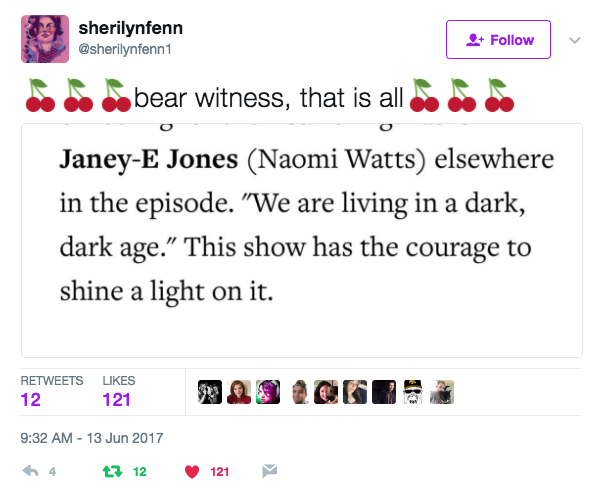
Sherilyn Fenn, aka Audrey Horne, quoted my review of the latest Twin Peaks and added a bunch of cherry emojis. So I’m dead now,
“Better Call Saul” thoughts, Season Three, Episode Nine: “Fall”
June 14, 2017Kim Wexler has lost control. Considering the company her partner and boyfriend Jimmy McGill will soon be keeping, if the worst thing that happens to her because of Jimmy is accidentally driving her car into a ditch, she’s gotten off easy. But while it’s easy to miss amid the fireworks between Jimmy and Chuck or the historical first meeting of Mike and Gus, not to mention Rhea Seehorn’s never-let-them-see-you-sweat performance, but this season has slowly ratcheted up the pressure on Kim to what turns out to be a physically unbearable degree. The episode is entitled “Fall,” and that’s basically what she does.
I reviewed this week’s very good Better Call Saul for the New York Observer. I talk about this elsewhere in the episode, but like Costa Ronin as Oleg Burov in The Americans, Michael Mando as Nacho Varga speaks barely a raised word and barely ever one in English and is delivering one of the best performances on television.
Lindsey Buckingham/Christine McVie – “Lindsey Buckingham/Christine McVie”
June 14, 2017A good chorus can put a whole lot of questions to bed—about a song, about a band, about a reason to get up in the morning, you name it. Fleetwood Mac, whose catalog is so festooned with world-bestriding hits that they can do a best-of reunion tour and leave “Sara” and “Hold Me” off the setlist, know this better than just about any other band. Their colossal pop collaborations kept them together through years of intense interpersonal turmoil and full decades of cordial détente. Like, in the grand scheme of things, is it really that big a deal if you left your bass-player husband for the light guy if the result is “You Make Loving Fun”?
Which brings us to the curious case of Lindsey Buckingham/Christine McVie, a Fleetwood Mac album in all but name—and the conspicuous absence of the third member of the band’s songwriting trinity. Ending what seemed like a permanent departure from the band, keyboardist and vocalist McVie returned to the fold in 2014 for a massive tour. After it wrapped, she and guitarist/vocalist/production whiz Buckingham headed back to the studio together for the first time in well over a decade, with drummer Mick Fleetwood and bassist John McVie joining them. As for Stevie Nicks, well: “What we do is go on the road, do a ton of shows and make lots of money. We have a lot of fun. Making a record isn’t all that much fun.”
Lindsey Buckingham/Christine McVie feels like a retort to Nicks’ statement. For McVie, the return to the band has been creatively invigorating as well as financially lucrative (Nicks herself gets that, facetiously describing McVie’s only other alternative to heading back to the studio: “‘Now I’m just gonna go back to London and sit in my castle for two years?’ She wanted to keep working”); Buckingham’s a born striver who kills time between tours by adding guitar texture to Nine Inch Nails records. Going on the road and making money is “what we do”? The pair’s collaboration feels like a “speak for yourself” in album form. To paraphrase a Rumours classic, they’ll make recording fun!
I reviewed the new album by bonafide pop-rock geniuses Lindsey Buckingham & Christine McVie for Pitchfork. It’s definitely fun, just not fundamental.
“Twin Peaks” Thoughts, Season Three, Episode Six
June 14, 2017Harry Dean Stanton is 90 years old, though he’s looked so world weary for so long that he seems somehow ageless and immortal. In light of the key Twin Peaks players who’ve died before the series’ return to the air – Jack Nance, Frank Silva, Frances Bay, Don S. Davis, Warren Frost, David Bowie, and most hauntingly Miguel Ferrer and Catherine Coulson, who reprised their roles as Albert Rosenfield and the Log Lady before they passed away – we’re fortunate to have him. When his character, Carl Rodd, tells his younger companion “I’ve been smokin’ for 75 years, every fuckin’ day,” he literally laughs in the face of his own mortality. But way back when we first met him in Fire Walk With Me, set nearly 30 years ago, he intimated to a pair of FBI agents investigating a Black Lodge–related murder that he’d seen too much. “I’ve already gone places,” he said. “I just want to stay where I am.”
Making Stanton’s Carl the Virgil on our journey to this episode’s particular Hell – the hit-and-run killing of a little boy by local monster Richard Horne (Eamon Farren) – lends even more weight to the moment. It provides a contrast between the old man’s long life – achieved against the medical odds, by his own admission – and the life of the little boy, cut so horrifically short. It offers an unparalleled range of emotion, beginning with him simply sitting on a bench and enjoying the wind and light through the trees and ending with him seeing one of the worst things a person can see. And whether he’s watching the boy’s soul ascend or simply providing his mother with human connection and validation by touching her and looking into her eyes, his role is just that: to see, to bear witness. It’s not that witnesses are in short supply – plenty of bystanders observe the accident and its aftermath. But when Carl takes the next step and comforts the grieving mother, he’s the only one to bear witness – bear as in a cross.
[…]
Two crucial links to the murdered child who set the entire chain of events in motion are uncovered in an episode that forces us to confront the killing of children face-on. Laura’s face appears in the opening credits every week, but this is a way to make her presence, and her absence, hit home. Doing any less would be a cop out, a dodge, a refusal to bear witness. “What kind of world are we living in where people can behave like this—treat other people this way, without any compassion or feeling for their suffering?” asks Janey-E Jones (Naomi Watts) elsewhere in the episode. “We are living in a dark, dark age.” This show has the courage to shine a light on it.
I reviewed this week’s extremely difficult Twin Peaks for Rolling Stone. I have to say, the response I’ve gotten to my writing on the season so far, and this episode in particular, is extremely gratifying. What it’s doing means a lot to me.
